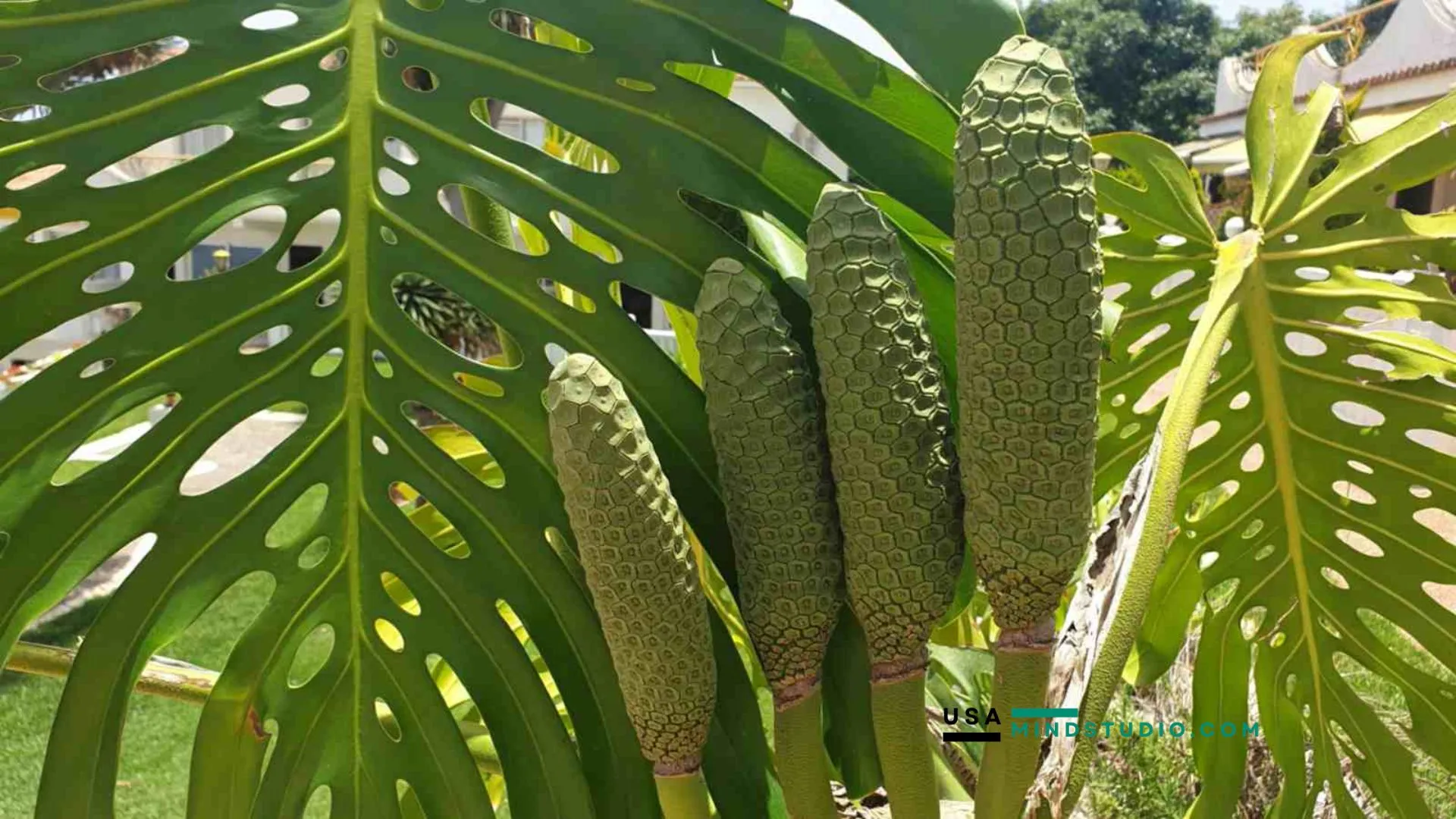
Growing and Ripening Monstera Deliciosa Fruit requires patience and the right techniques. The fruit takes 12-14 months to fully ripen, developing a sweet, tropical flavor similar to banana and pineapple. This guide covers ideal growing conditions, ripeness indicators, safe harvesting, and proper storage to ensure a delicious and safe experience while avoiding calcium oxalate exposure. Whether you’re a beginner or experienced grower, learn how to successfully cultivate and enjoy your own Monstera fruit at home.
Key Takeaways:
- – The Monstera Deliciosa fruit requires 12-14 months to fully ripen, developing from a green, scaled exterior to a sweet, edible fruit with combined flavors of pineapple and banana.
- – Successful fruit development depends on optimal growing conditions, including high humidity, well-drained soil, and regular application of a balanced organic fertilizer.
- – The ripening process must be carefully monitored to avoid consuming unripe fruit, which contains calcium oxalate that can cause irritation.
- – Proper harvesting involves waiting for the fruit’s outer green scales to naturally begin lifting – a key indicator of ripeness.
- – The fruit can be ripened safely by storing it in a paper bag at room temperature, similar to ripening other tropical fruits.
Understanding Monstera Deliciosa: The Fruit Salad Plant
Monstera deliciosa, commonly known as the fruit salad plant, is a fascinating tropical vine that’s captured the hearts of plant enthusiasts worldwide. Native to the rainforests of Central America, this remarkable plant offers more than just its iconic split leaves.
Origin and Natural Habitat
In its natural environment, Monstera deliciosa thrives in the warm, humid conditions of tropical rainforests. The plant climbs up tree trunks using its aerial roots, reaching heights where it can produce its unique fruit. These natural conditions play a crucial role in the plant’s ability to flower and fruit successfully.
The Unique Fruit
The fruit of Monstera deliciosa is truly one-of-a-kind. It resembles an elongated green corn cob, typically growing 8-12 inches long. The hexagonal scales covering its surface give it a distinctive appearance that sets it apart from other tropical fruits. When fully ripe, these scales naturally fall off, revealing the creamy white flesh beneath.
Why “Fruit Salad Plant”?
This intriguing nickname comes from the fruit’s complex flavor profile. When properly ripened, it offers a delightful combination of tropical tastes – imagine a blend of pineapple, banana, mango, and coconut all in one bite. This unique flavor combination has made it a sought-after delicacy in many tropical regions.
Cultural Significance
In its native regions, particularly Mexico and Guatemala, the fruit holds cultural importance and is often used in traditional dishes and beverages. Local communities have been cultivating and enjoying this fruit for generations, incorporating it into their culinary heritage.
💡 Key Takeaway: Monstera deliciosa is a tropical vine producing unique, hexagonal-scaled fruit with a complex flavor profile combining multiple tropical fruits, earning it the nickname “fruit salad plant.”
Creating Optimal Growing Conditions
Light Requirements
Monstera deliciosa thrives in bright, indirect sunlight to produce healthy fruit. Place your plant near an east or north-facing window where it receives filtered light throughout the day. Direct sunlight can scorch the leaves and negatively impact fruit development. If growing indoors, consider using sheer curtains to diffuse intense light.
For optimal fruit production, ensure your plant receives 6-8 hours of indirect light daily. During winter months, you might need to supplement with grow lights to maintain consistent light levels. Position the grow lights about 12-18 inches above the plant to prevent leaf burn.
Temperature and Humidity Control
Maintaining proper temperature and humidity is crucial for successful Monstera fruit development. Keep temperatures between 65-85°F (18-29°C) for ideal growth. The plant can tolerate brief periods outside this range but prolonged exposure to temperatures below 50°F (10°C) can damage fruit development.
Humidity plays a vital role in fruit production. Aim for humidity levels between 60-80%. You can increase humidity by:
– Using a humidifier near the plant
– Placing the pot on a pebble tray filled with water
– Grouping plants together to create a microclimate
– Misting the leaves regularly (avoid misting developing fruit)
During winter, when indoor heating can dry out the air, pay extra attention to maintaining adequate humidity. Consider using a hygrometer to monitor moisture levels and adjust accordingly.
The growing space should also have good air circulation to prevent fungal issues, but avoid placing the plant in drafty areas near air conditioning vents or heating units.
💡 Key Takeaway: Create an environment with bright indirect light, temperatures between 65-85°F, and 60-80% humidity while ensuring good air circulation to support healthy Monstera fruit development.
Fruit Development Process
The journey from flower to fruit for a Monstera deliciosa is a fascinating process that requires patience and optimal growing conditions. The plant needs to reach maturity, typically around 3-4 years old, before it can produce fruit.
From Flower to Fruit Formation
The process begins with the emergence of a spathe and spadix – the characteristic flower structure of Monstera plants. The spathe is a large, boat-shaped leaf that protects the spadix, a spike-like structure covered in tiny flowers. As pollination occurs, these flowers transform into small, hexagonal segments that will eventually become the fruit.
The initial fruit development is slow, taking several months for the fruit to reach its full size. During this period, the fruit remains green and firm, covered in a distinctive hexagonal pattern that resembles scales or kernels on the surface.
Ripening Timeline and Changes
Once the fruit reaches its full size, the ripening process begins. This typically takes 12-14 months from the initial flower formation. The most noticeable change is the gradual yellowing of the fruit’s scales, starting from the base and moving upward. These scales will naturally begin to lift and fall off as the fruit ripens.
The fruit’s aroma also becomes more pronounced during ripening, developing a sweet, tropical fragrance. The flesh beneath the scales softens progressively, though it’s crucial not to rush this process as unripe fruit contains high levels of calcium oxalate crystals that can cause irritation.
💡 Key Takeaway: Monstera fruit development is a lengthy process spanning over a year, beginning with flower formation and ending with the gradual ripening of the hexagonal-scaled fruit from bottom to top.
Identifying Ripeness
The journey from a raw Monstera fruit to a perfectly ripe delicacy requires careful observation and patience. Understanding the telltale signs of ripeness is crucial for both safety and optimal flavor.
Visual Changes
The most noticeable indicator of ripening is the color transformation. Initially, the fruit displays a green exterior with distinctive hexagonal scales. As it matures, these scales begin to darken and turn yellowish-green. When fully ripe, the scales naturally separate and fall off, revealing the edible flesh underneath.
Physical Indicators
A gentle squeeze test can help determine ripeness. The fruit should yield slightly when pressed, similar to a ripe avocado. If it’s rock-hard, it needs more time. The scales will also become loose and start falling off on their own – never force them off as this can damage the fruit.
Aroma Development
As the fruit approaches peak ripeness, it develops a sweet, tropical fragrance. This scent becomes more pronounced as the ripening process continues. If there’s no detectable aroma, the fruit likely needs more time to mature.
Time-Based Assessment
Typically, Monstera fruit takes about 12-14 months to develop fully on the plant. Once harvested, it usually needs another 5-7 days to ripen completely at room temperature. However, this timeline can vary based on environmental conditions and the fruit’s initial state.
💡 Key Takeaway: Monitor your Monstera fruit’s ripeness through visual changes, physical softness, and aroma development – the scales should naturally separate when ready, revealing sweet, edible flesh underneath.
Harvesting Techniques
The timing of your harvest plays a crucial role in enjoying the perfect Monstera fruit. Let’s explore the best techniques to ensure you pick your fruit at just the right moment.
Visual Indicators
Look for hexagonal scales that begin to lift and separate naturally. The fruit should have a yellowish-green tint, and some scales may start falling off on their own. If the scales are still tightly packed and green, it’s too early to harvest.
Physical Signs
Gently squeeze the fruit – it should yield slightly to pressure, similar to a ripe avocado. The aroma will become more pronounced, developing a sweet, tropical fragrance. When you notice these changes, your Monstera fruit is ready for picking.
Proper Removal Method
Use clean, sharp pruning shears to cut the fruit stalk about 2-3 inches above the fruit. Avoid pulling or twisting the fruit off, as this can damage both the fruit and the plant. Always wear gloves during harvesting to protect your skin from any sap.
Post-Harvest Care
Once harvested, place the fruit in a paper bag at room temperature to continue ripening. Check daily for scale shedding and softening. The fruit typically needs 3-5 additional days to reach peak ripeness after harvesting.
💡 Key Takeaway: Harvest Monstera fruit when scales begin lifting and the color turns yellowish-green, using clean pruning shears and allowing post-harvest ripening for optimal taste and safety.
Post-Harvest Care and Storage
When it comes to caring for your harvested Monstera fruit, proper storage and handling are crucial for achieving the best flavor and ensuring food safety.
Optimal Storage Conditions
Store your harvested Monstera fruit at room temperature (around 65-75°F) in a well-ventilated area. Keep it away from direct sunlight and high humidity to prevent premature spoilage. Place the fruit on a clean, dry surface and avoid stacking multiple fruits together.
Ripening Process
Monitor your fruit daily for signs of ripening. The hexagonal scales will naturally begin to lift and fall off, revealing the edible flesh underneath. This process typically takes 3-5 days, depending on when you harvested the fruit. A sweet, tropical aroma will develop as it ripens.
Handling Tips
Always handle your Monstera fruit with clean hands to prevent contamination. If you notice any mold or unusual discoloration, discard the fruit immediately. Once the fruit is fully ripe, consume it within 2-3 days for the best taste and texture.
Storage After Ripening
Once ripe, you can store cut portions in an airtight container in the refrigerator for up to 48 hours. However, the fruit is best enjoyed fresh. If you can’t eat it all at once, consider sharing with friends or family to minimize waste.
💡 Key Takeaway: Proper post-harvest care involves storing Monstera fruit at room temperature, monitoring ripening signs, maintaining cleanliness, and consuming within the optimal timeframe for the best experience.
Taste Profile and Consumption
Unique Flavor Combination
Monstera deliciosa fruit offers an extraordinary taste experience, combining the sweetness of tropical fruits like pineapple and banana with subtle hints of mango and coconut. The texture is uniquely creamy, similar to ripe banana but with a slight firmness that adds to its appeal.
Safe Consumption Guidelines
Before consuming, ensure the fruit’s hexagonal scales fall off naturally, revealing the creamy white flesh underneath. Never eat unripe fruit as it contains high levels of calcium oxalate crystals that can cause severe throat irritation and discomfort.
Serving Suggestions
The fruit can be enjoyed fresh, cut into bite-sized pieces. Some people prefer adding it to fruit salads or blending it into smoothies. Store any unused portions in an airtight container in the refrigerator for up to 2 days to maintain freshness.
💡 Key Takeaway: Monstera fruit offers a unique tropical flavor blend but must be fully ripened before consumption to avoid health risks, with proper storage ensuring optimal taste and safety.
Conclusion
Growing and ripening Monstera fruit is a rewarding journey that requires dedication, patience, and attention to detail. By following the guidelines outlined in this guide, you can successfully cultivate this exotic delicacy and enjoy its unique pineapple-banana flavor blend safely. Remember, the key to success lies in providing optimal growing conditions, maintaining proper humidity levels, and using the right fertilization techniques. Always prioritize safety when handling and consuming the fruit, being mindful of the calcium oxalate crystals and waiting for the hexagonal scales to naturally lift before eating. Whether you’re a seasoned plant enthusiast or just starting your Monstera growing journey, the satisfaction of harvesting your own fruit salad plant makes the year-long wait worthwhile. Start implementing these techniques today, and you’ll be well on your way to enjoying this tropical delicacy right from your own home. Share your Monstera growing experience with fellow enthusiasts and join the growing community of successful cultivators.
FAQs
How long does it take for a Monstera plant to produce fruit?
A Monstera plant typically takes 2-3 years to mature enough to produce fruit when grown in optimal conditions. However, indoor plants may take longer or might not fruit at all. The plant needs to reach maturity and have proper environmental conditions to initiate fruit production.
Can Monstera fruit cause allergic reactions?
Yes, unripe Monstera fruit contains high levels of oxalic acid which can cause allergic reactions like throat irritation and stomach discomfort. Always ensure the fruit is fully ripe before consumption, and if you have sensitive skin, wear gloves while handling the fruit.
What does ripe Monstera fruit taste like?
Ripe Monstera deliciosa fruit has a unique flavor profile combining pineapple, banana, and passion fruit notes. The taste bud experience is often described as a tropical fruit salad, which is why it’s nicknamed the fruit salad plant.
Can I grow Monstera fruit indoors in cold climates?
While Monstera can grow as a houseplant in any climate, fruiting indoors in cold regions is challenging. The plant needs high humidity, warm temperatures, and plenty of light to produce fruit. Consider using a greenhouse or sunroom for better results.
How do I know when to harvest Monstera fruit?
Harvest Monstera fruit when the protective individual outer segments begin to naturally separate and become loose. The fruit should have a subtle sweet aroma, and the scales of the fruit should be easily removable. This usually occurs after about a year of growth.
Is it safe to eat Monstera fruit during pregnancy?
While ripe Monstera fruit is generally safe to eat, pregnant women should consult their healthcare provider before trying it. The high content of vitamin C and other nutrients can be beneficial, but individual sensitivities may vary.


